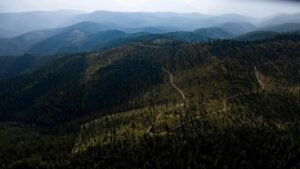Big, fearsome and boasting an enormous pair of jaws, the star of Hollywood’s The Meg left even movie tough guy Jason Statham aghast at his size.
Now researchers say the giant prehistoric shark megalodon may have been slimmer than previously thought.
Scientists say previous reconstructions of the extinct animal, also known as the megatooth shark, were flawed because they were based on an assumption that its body shape resembled a larger version of the great white shark, the planet’s largest living predatory fish.
Instead, the team says a new analysis of measurements from an incomplete set of megalodon fossil vertebrae suggests it looked quite different, with a longer and slimmer body.
“Our study suggests that the modern great white shark does not necessarily serve as a good modern analog to assess at least certain aspects of its biology, including its size,” said Prof. Kenshu Shimada, a paleobiologist at DePaul University in Chicago and the senior author said. of the study.
But, he added, “The reality is that we need the discovery of at least one complete megalodon skeleton to have more confidence about its true size as well as its body shape.”
Writing in the journal Palaeontologia Electronica, Shimada and his colleagues report how an earlier study recorded the measured vertebral column of an incomplete megalodon fossil at 11.1 meters long. However, other work suggested that the length of the same fossil, estimated from the proportions of the great white, was 9.2 meters.
Among other things, the team notes that in some cases a young great white was used as a model for megalodon, while there are also differences between the ratio of the length of the jaw to the vertebrae for the two species.
Together with recent research, including estimates of the prehistoric behemoth’s cruising speeds, the team concludes that it is a mistake to model the body shape of megalodon on the proportions of the great white and that analysis suggests that the prehistoric animal was more extended.
“However, the slender body would indicate that megalodon may not have been a powerful swimmer like the modern great white shark is,” Shimada said, adding that the observation is consistent with his recent study suggesting that megalodon may have been a shark that slowly sail. with occasional “burst swimming” to catch prey.
“As one of the largest carnivores to have ever existed, deciphering the biology of megalodon is critical to understanding the role played by large carnivores in the context of the evolution of marine ecosystems and how their extinction influenced the development of the modern ocean,” he said. said.
Prof John Hutchinson of the Royal Veterinary College, who was co-author some of the research the new newspaper criticism, said his team did not only use the proportions of the great white to help reconstruct megalodon’s body shape but also used the measurements of other sharks, while the new study does not prove that such an approach is inappropriate.
“They don’t falsify our hypothesis, they cast doubt on it,” he said.
Hutchinson added that the new study, paradoxically, also uses comparisons with the great white’s anatomy, but does not offer alternative estimates for megalodon’s dimensions.
Fundamentally, he said, the work doesn’t change the fact that megalodon was an enormous, fearsome shark. “It was one of the largest oceanic predators ever,” he said. “It would have been absolutely terrifying.”
Developing images
Megalodon is not the only prehistoric animal whose image has evolved over time. Here are some others:

Not so fast: With an enormous body, large teeth and sharp claws, T rex was a fearsome predator. However, it wasn’t as fast as films like Jurassic Park suggest. Research published in 2021 suggests that they are a walking pace of just under 3mphwhile another study as of 2011, their top speed is set at around 25mph.
Size business: In general, as dinosaurs got bigger, the mammals that lived alongside them got smaller. But this was not always the case. Velociraptors were about the size of a turkey, while research has revealed that some mammals were as big as a badger or dog.
No pushovers: Some dinosaurs were fearsome carnivores, but mammals were not necessarily timid. A recently discovered fossil shows a mammal attacking a dinosaur, while others the same mammal species with the bones of a baby dinosaur where its stomach would have beensuggesting that it was a meaty snack.
Ruffled Feathers: “In the books I read as a child in the 80s and 90s, dinosaurs were depicted as green, scale-covered animals, but the discovery of feathered dinosaur fossils in China in the mid-1990s showed that many dinosaurs would have looked much more. like birds,” said Prof Steve Brusatte, a palaeontologist at the University of Edinburgh. “It’s a shocking image change.”





